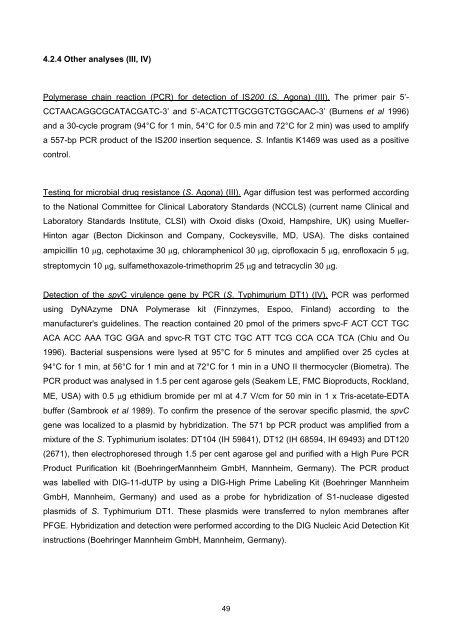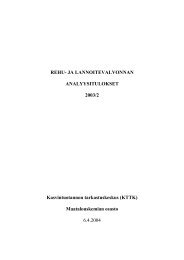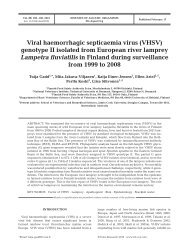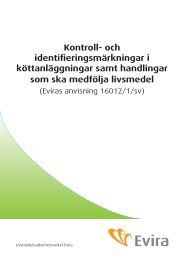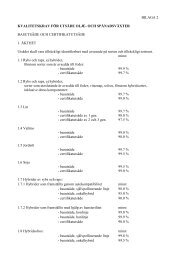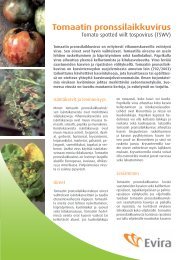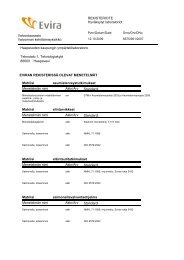Molecular characterization of endemic salmonella infections ... - Evira
Molecular characterization of endemic salmonella infections ... - Evira
Molecular characterization of endemic salmonella infections ... - Evira
Create successful ePaper yourself
Turn your PDF publications into a flip-book with our unique Google optimized e-Paper software.
4.2.4 Other analyses (III, IV)<br />
Polymerase chain reaction (PCR) for detection <strong>of</strong> IS200 (S. Agona) (III). The primer pair 5’-<br />
CCTAACAGGCGCATACGATC-3’ and 5’-ACATCTTGCGGTCTGGCAAC-3’ (Burnens et al 1996)<br />
and a 30-cycle program (94°C for 1 min, 54°C for 0.5 min and 72°C for 2 min) was used to amplify<br />
a 557-bp PCR product <strong>of</strong> the IS200 insertion sequence. S. Infantis K1469 was used as a positive<br />
control.<br />
Testing for microbial drug resistance (S. Agona) (III). Agar diffusion test was performed according<br />
to the National Committee for Clinical Laboratory Standards (NCCLS) (current name Clinical and<br />
Laboratory Standards Institute, CLSI) with Oxoid disks (Oxoid, Hampshire, UK) using Mueller-<br />
Hinton agar (Becton Dickinson and Company, Cockeysville, MD, USA). The disks contained<br />
ampicillin 10 μg, cephotaxime 30 μg, chloramphenicol 30 μg, cipr<strong>of</strong>loxacin 5 μg, enr<strong>of</strong>loxacin 5 μg,<br />
streptomycin 10 μg, sulfamethoxazole-trimethoprim 25 μg and tetracyclin 30 μg.<br />
Detection <strong>of</strong> the spvC virulence gene by PCR (S. Typhimurium DT1) (IV). PCR was performed<br />
using DyNAzyme DNA Polymerase kit (Finnzymes, Espoo, Finland) according to the<br />
manufacturer's guidelines. The reaction contained 20 pmol <strong>of</strong> the primers spvc-F ACT CCT TGC<br />
ACA ACC AAA TGC GGA and spvc-R TGT CTC TGC ATT TCG CCA CCA TCA (Chiu and Ou<br />
1996). Bacterial suspensions were lysed at 95°C for 5 minutes and amplified over 25 cycles at<br />
94°C for 1 min, at 56°C for 1 min and at 72°C for 1 min in a UNO II thermocycler (Biometra). The<br />
PCR product was analysed in 1.5 per cent agarose gels (Seakem LE, FMC Bioproducts, Rockland,<br />
ME, USA) with 0.5 μg ethidium bromide per ml at 4.7 V/cm for 50 min in 1 x Tris-acetate-EDTA<br />
buffer (Sambrook et al 1989). To confirm the presence <strong>of</strong> the serovar specific plasmid, the spvC<br />
gene was localized to a plasmid by hybridization. The 571 bp PCR product was amplified from a<br />
mixture <strong>of</strong> the S. Typhimurium isolates: DT104 (IH 59841), DT12 (IH 68594, IH 69493) and DT120<br />
(2671), then electrophoresed through 1.5 per cent agarose gel and purified with a High Pure PCR<br />
Product Purification kit (BoehringerMannheim GmbH, Mannheim, Germany). The PCR product<br />
was labelled with DIG-11-dUTP by using a DIG-High Prime Labeling Kit (Boehringer Mannheim<br />
GmbH, Mannheim, Germany) and used as a probe for hybridization <strong>of</strong> S1-nuclease digested<br />
plasmids <strong>of</strong> S. Typhimurium DT1. These plasmids were transferred to nylon membranes after<br />
PFGE. Hybridization and detection were performed according to the DIG Nucleic Acid Detection Kit<br />
instructions (Boehringer Mannheim GmbH, Mannheim, Germany).<br />
49


